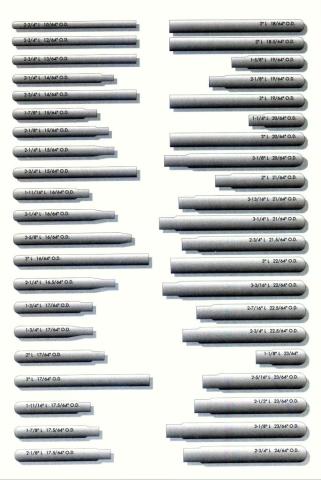
Many pen collectors like to do their own repairs and are quite capable of doing so. However, if you are new to repairing vintage writing instruments, we strongly suggest that you proceed with caution. Start out with some junkers before you launch into restoring that recently acquired oversized Doric. Vintage pens are fragile relics of the past and it becomes more important all the time to try and preserve them in the best way known. We sell both books and supplies for your pen repairs. If you are the least bit uncertain as to how to proceed with a repair, we recommend contacting a professional pen repair person. In other words, please let your common sense prevail!
These are basic instructions for lever filling fountain pens; note that there are slight variances among vintage fountain pens – even lever fillers. If in doubt, consult a pen repair person!
- Remove the section from barrel, they are usually friction fit, but there are some that are threaded. If friction fit, gently wiggle back and forth or apply gentle heat from hair dryer to loosen. Gentle heat will also loosen up threaded sections.
- Remove/scrape old sac remains from section nipple and inside of barrel. Xacto knives work well for this. Nipple must be clean and dry in order for new sac to adhere properly.
- Cut sac lengthwise, so that it is not longer than the end of the lever when the barrel is on section. See drawing above.
- Apply light coat of orange shellac or clear nail polish to sac nipple. Slip sac evenly over the nipple. Let dry at least 4-5 hours.
- Replace barrel on section. Do NOT glue the section and barrel together.
Ink up and Write, preferably after 24 hours!
Quick Pen Sac Reference for Common Vintage Pens - Ink sacs are generally identified by shape and size. The two basic shapes are straight sacs which are of constant diameter over their entire length, and necked sacs which becomes more narrow near the opening of the mouth of the sac. A third shape is tapered sac which becomes narrower toward the bottom end, forming a cone shape.
The size of a pen sac is expressed in 64ths of an inch in the outside diameter (OD). All that is necessary is a good measurement of the inside diameter of the pen barrel in 64ths of an inch.
Below are listed some common fountain pens:
Esterbrook J Series - #SAC-16
Sheaffer Touchdown - #SAC-15
Sheaffer Snorkel - #SAC-14
Sheaffer PFM - #SAC-17
Parker 51 vacumatic fill - #DEB-DIA
Parker 51 aerometric fill - #SAC-16T
Parker Vacumatic major or standard sizes - #STD-DIA
Parker Vacumatic debutante sizes - #DEB-DIA
Parker Sr. Duofold - #SAC-23-2 1/2N
Parker Jr. Duofold - #SAC-21-2N
Waterman 52 series - #SAC-17
Eversharp Skyline - #SAC-16T
NOTES: N in a number designation means the sac is necked (narrower at open end). T in a number designation means the sac is tapered at the closed end.. We do not carry all pen sacs shown below, we carry the most popular sizes, which will fit almost all vintage pens!
Length of pen with cap on over the nib
Diameter of the cap opening
Brand of pen, model name, type of filling system if known.
Any other info you can provide on the pen could be helpful.
All pen sacs sold by Pendemonium are made exclusively by The Pen Sac Company
We carry most sizes of pen sacs and diaphragms. If you are unsure as to what size sac to order, feel free to email us for assistance. Pen sac diameters are measured in 64ths of an inch. For example, a #14 size pen sac is 14/64 inch. All straight sacs are made long and can be easily trimmed with scissors to proper length. All pen sacs sold by Pendemonium are made exclusively by The Pen Sac Company.
For a complete a Pen Sac Co compatibility chart, click the link here: Pen Sac Co Compatibility Chart
Aside from using pen sacs as their intended purpose, they have a few other useful alternative purposes as well! Use a rubber sac to oxidize your sterling silver pens in recessed areas, the Parker 75 sterling cisele pen is a good example. The rubber sac and the gas it produces is a slow way to oxidize sterling silver. This is much easier and controllable than getting the pen completely black with liver of sulfur solution.
A #22 sac is a snug fit, but can be worked on around the cap and/or barrel of a 75 FP or RB, easy fit for BP or MP. The #23 1/2N sac slides over the FP & RB easiest, BUT, the neck of the sac has to be trimmed off first so it will fit. The 22 sacs are about 3 inches long, so one on each end of pen fits over FP, RB, BP or MP. The 23 1/2N when cut is only 2.25 inches, so it would take 3 of them to completely cover any instrument, the one in the center would need to be cut open at both ends. While totally non-pen related, the smaller sized sacs, usually #10, #12 and #14 are used by model airplane enthusiasts for fuel tanks!

 Follow us on Facebook!
Follow us on Facebook!